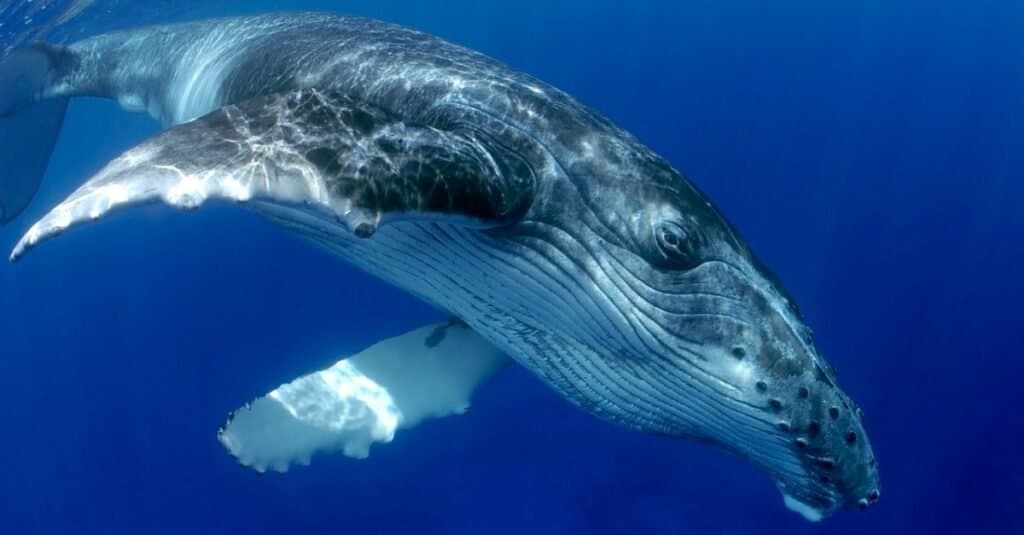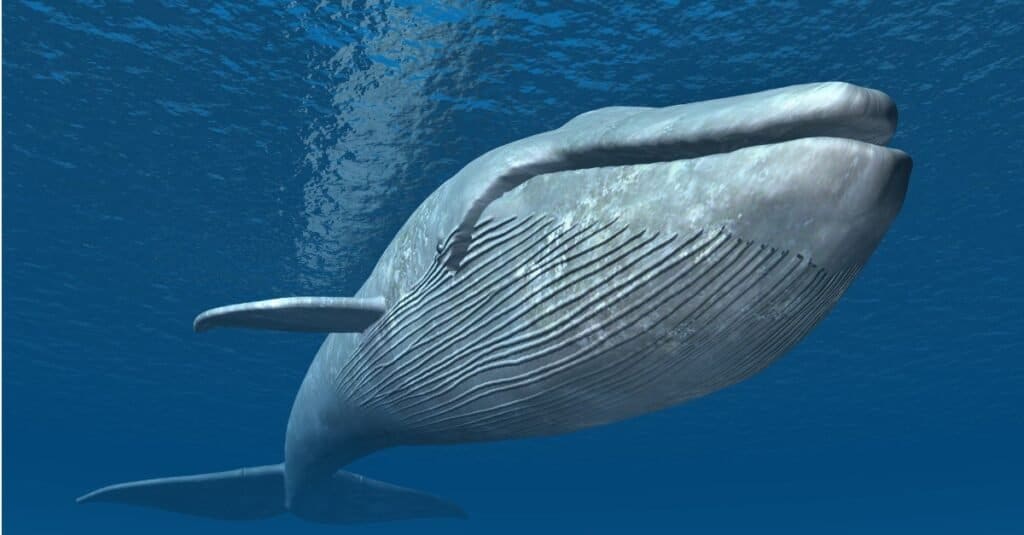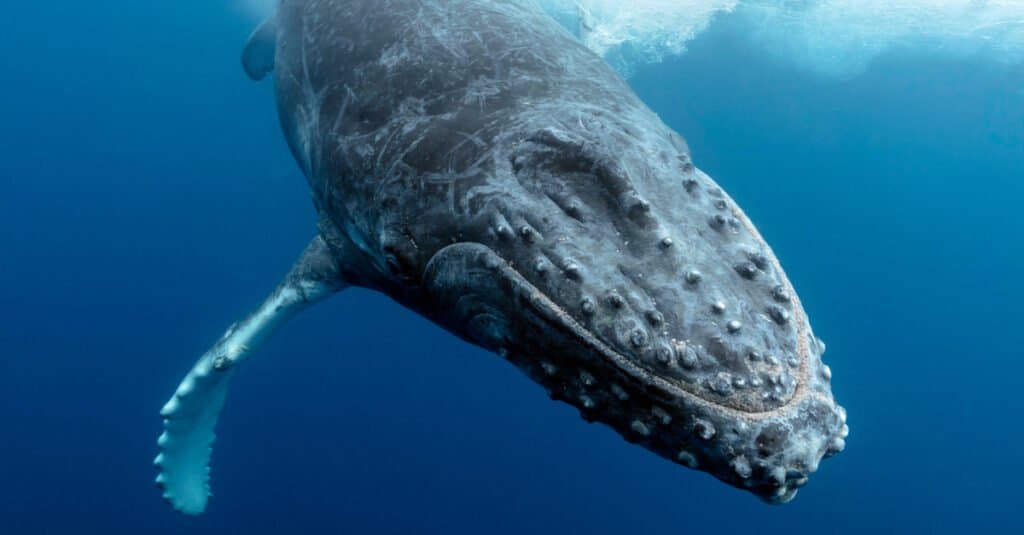While they are both from the same family, there are some significant differences between the blue whale vs humpback whale. You may not be able to tell the differences between them currently, but you are in the right place to learn more. What differences separate these two whales from one another, and what similarities bring them together?
In this article, we will compare and contrast the humpback whale and the blue whale so that you can learn everything there is to know about both distinct species. We will address their physical differences as well as their habitat preferences, along with their diets. Finally, we will address their life spans as well as a few other tricks you can learn to tell them apart. Let’s get started and talk about these majestic creatures now!
Comparing Blue Whale vs Humpback Whale

| Blue Whale | Humpback Whale | |
|---|---|---|
| Size | 80-100 feet long; 100-160 tons | 50-60 feet long; 40-100 tons |
| Appearance | Slim and slender body, despite its huge length; dark blue and rubbery skin, with pleats along its throat. Two blowholes in top of head and has a large baleen for eating its unique diet | Dark gray back with lighter underbelly. Covered in large ridges and scars, along with a hump near its dorsal fin. Has a baleen instead of teeth |
| Location and Habitat | Found in both cold and tropical oceans, depending on the species. Migrates twice a year on average, and can be found off the coasts of North Atlantic and Pacific seas | Migrates up to 16,000 miles in a year, from cold or polar climates into warm, subtropical seas, depending on the season |
| Diet | Primarily krill, though also eats fish and small crustaceans | Primarily plankton, though also eats krill and other crustaceans |
| Lifespan | 30-45 years | 45-50 years |
Key Differences Between Blue Whale vs Humpback Whale

The humpback whale lives a slightly longer lifespan when compared to the lifespan of the average blue whale.
©iStock.com/Yann-HUBERT
There are many key differences between the blue whale and the humpback whale. The blue whale grows far larger than the humpback whale, in both length and weight. The humpback whale has more unique markings compared to the slender blue whale. In addition, the humpback whale lives a slightly longer lifespan when compared to the lifespan of the average blue whale.
Let’s go over all of these differences and more in detail now.
Blue Whale vs Humpback Whale: Size

Depending on age and gender, the average humpback whale ranges in length from 50 to 60 feet long, while the blue whale ranges anywhere from 80 to 100 feet long.
©Andrew Sutton/Shutterstock.com
There are some significant differences between the size of the average blue whale and the size of the average humpback whale. In general, the blue whale is much larger than the humpback whale, in both length and weight. But just how much larger is the blue whale compared to the humpback whale? Let’s take a closer look at the figures now.
Depending on age and gender, the average humpback whale ranges in length from 50 to 60 feet long, while the blue whale ranges anywhere from 80 to 100 feet long. In addition, the blue whale weighs an average of 100 to 160 tons, while the humpback whale weighs anywhere from 40 to 100 tons. As you can see, there is some overlap in their weights, though the blue whale still grows far larger than the humpback whale.
Blue Whale vs Humpback Whale: Appearance

The humpback whale has more unique markings overall compared to the average blue whale.
©Claude Huot/Shutterstock.com
Given that the blue whale and the humpback whale are members of the same whale family, there are some similarities in their appearances. However, the humpback whale has more unique markings overall compared to the average blue whale. In addition, the blue whale maintains a light gray to bluish shade, while the humpback whale is gray on its back and white on its underbelly.
Something that usually easily distinguishes a humpback whale from any other whale is the fact that the humpback whale has a small ridge or hump near its dorsal fin, something that the blue whale does not have. However, both of these whales have baleens that help them feed on their unique diets.
Blue Whale vs Humpback Whale: Location and Habitat

The blue whale is often found off the coast of the North Atlantic and Northern Pacific seas, while the humpback whale tends to prefer one extreme region or the other.
©iStock.com/MR1805
Both the blue whale and the humpback whale are migratory whales, capable of traveling a number of miles every year. However, the humpback whale migrates more consistently and regularly compared to the blue whale. It is estimated that humpback whales travel an average of 16,000 miles per year, back and forth from subtropical waters to polar regions, depending on the season.
This isn’t to say that the blue whale doesn’t migrate, as it also chooses where it lives depending on the season and food availability. However, the blue whale is often found off the coast of the North Atlantic and Northern Pacific seas, while the humpback whale tends to prefer one extreme region or the other, depending on time of year.
Blue Whale vs Humpback Whale: Diet

The blue whale eats krill as its primary source of food, while the humpback whale prefers plankton varieties.
©Craig Lambert Photography/Shutterstock.com
Both the blue whale and the humpback whale enjoy a similar diet, and one that accommodates their unique eating strategy using baleens. For example, the blue whale eats krill as its primary source of food, while the humpback whale prefers plankton varieties. However, both of these whales also eat fish and other crustaceans as part of their diets.
Blue Whale vs Humpback Whale: Lifespan

Given its large size, the blue whale lives a slightly shorter lifespan compared to the average humpback whale.
©Wild_and_free_naturephoto/Shutterstock.com
The final difference between a humpback whale and a blue whale has to do with their lifespans. Given its large size, the blue whale lives a slightly shorter lifespan compared to the average humpback whale. Taking a closer look at the figures, the humpback whale lives anywhere from 45 to 50 years, while the blue whale lives an average of 30 to 45 years. While there are a lot of environmental factors that affect the lifespans of both of these creatures, it is safe to say that the humpback whale does indeed live a slightly longer life span overall.
The photo featured at the top of this post is © Claude Huot/Shutterstock.com
Thank you for reading! Have some feedback for us? Contact the AZ Animals editorial team.






